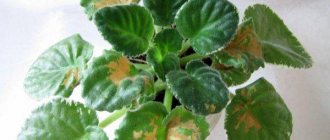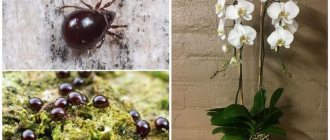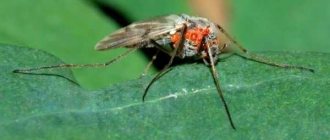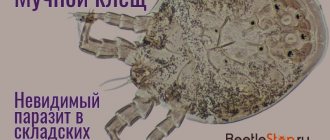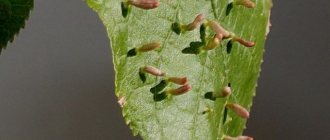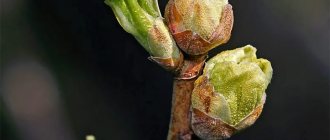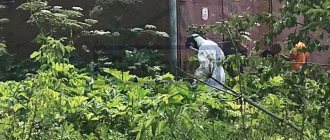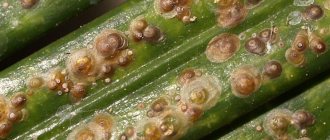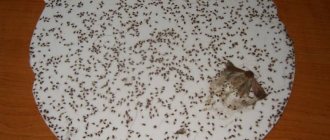Description of the disease
The feather mite is a dangerous parasite that lives in the cavities of the flight, contour or tail feathers of birds. Infection with such a pest is called syringophilosis . If you do not provide assistance to the wavy in a timely manner, this will lead to negative and irreversible consequences for its plumage and health. Treatment is considered fairly simple if you follow the veterinarian's instructions exactly.
Tick mites have an elongated body, which is approximately 1 mm in length, and are also brown or yellow in color. Parasites live in colonies, so up to 100 insects can live in one feather. To get into the edge of each feather, special small channels are created connecting the edge with the body of the wavy.
What does a bud mite look like on a budgie - photo:
Types of ticks dangerous to birds
Poultry often suffer from various mites. Small pests, invisible to the eye, live in the bodies of birds and feed on living tissues. Some types of parasites are dangerous for budgies, as they cause serious pathologies of feathers, skin and stratum corneum. In combination with other diseases, poor care, and a weakened immune system, mites multiply freely and plague the bird with constant itching.
Feather and feather mites
The common mite - syringophilosis (lat. Syringophilus bipectinatus) in parrots manifests itself as damage to the flight and tail feathers. Colonies inhabit the cavities of the ears, feeding on exudate and lymph. The shaft of an infected feather becomes black, its structure is destroyed, and the skin around it becomes inflamed. Adult females lay eggs at the base of the feather. Due to impaired blood supply, feathers break off and fall out.
Feather mites in parrots are not so easy to find, but they are also dangerous. It is a parasite with a flattened yellowish body about 2 mm long. Its food is skin cells, feather particles, and fatty grease. Down feather eaters gnaw off the beards of the feathers, leaving only the feather shafts. Over time, deformed feathers fall out, and bald patches of skin appear in their place.
Note: Feather mites can be detected by removing the perch and tapping it on a piece of white paper.
Scabies mites
One of the common diseases in parrots is knemidocoptic mange (scabies). The causative agent is a microorganism of the genus Knemidocoptes. It has a rounded body measuring 0.3 - 0.5 mm. It affects non-feathered parts of the body: the area of the beak and cere, paws, skin around the eyes, cloaca.
Scabies mites live in the skin of parrots, feed, and make their own passages. Females leave eggs there. During their life, pests release toxic waste into the tissues, which poisons the bird’s body.
Tracheal pliers
The tracheal mite lives on the mucous membrane of the trachea and lungs of an infected parrot. The disease is called sternostomosis. The causative agent is Sternostoma tracheacolum, a tiny organism measuring from 0.1 to 0.6 mm. It moves in the respiratory organs of the bird with the help of its paws and claws. Females reach the lungs, lay eggs there, and then move into the air sacs.
Life cycle 2 – 3 weeks. The mite irritates the mucous membrane, mucus secretion increases, and the parrot coughs and sneezes. Parasites and their eggs are partially excreted by coughing and settle on food, water, and cage accessories. Thus, other birds are at risk of becoming infected with tracheal mites.
What is the danger?
The main negative consequences of this pest include the destruction of the internal structure of the feather at the base. Therefore, serious inflammation occurs in the area of skin located next to the damaged feather.
Usually, wavy mites become infected with the tick mite in spring or summer, but in winter and autumn the parasites hibernate.
Insects feed on lymph, so they form colonies on new feathers. Females lay a large number of eggs in the canals, which leads to the formation of larvae.
It is also useful to read: What mites can budgerigars have?
What stages does the disease go through?
Acariasis in parrots has several stages:
- Initial. At this stage, infection occurs. No special manifestations are visually observed. The progression of the disease depends on the condition of the bird. With increased immunity, the body of a feathered pet defeats the disease. But with vitamin deficiency, malnutrition or skin irritation, parasites easily take root on the body of parrots and begin to actively reproduce.
- Easy. Birds become restless, pull out feathers, and itch. The above symptoms appear depending on the type of parasite.
- Average. Characterized by a massive increase in the colony of mites. The parrots stop eating, become lethargic, and spend all their time combing and pulling out feathers. Infected birds itch against the bars of the cage, peck the skin until it bleeds, and try in every possible way to get rid of the unbearable itching caused by the parasites. At this stage, you should immediately begin to treat your feathered pet in order to protect it from possible complications.
- Heavy. Intoxication of the parrot's body occurs with waste products of parasites. Manifestations include lethargy, significant weight loss, suffocation, lethargy, and coma. Damage to the nervous system leads to paralysis and death. With tracheal acaryosis, it is impossible to save the bird at this stage (the lungs are completely blocked by parasites). For other types of pathology, immediate veterinary intervention may help.
Causes of infection
A bud mite can appear on a budgie for a variety of reasons. This is usually due to the following reasons:
- contact with an infected individual , for example, if birds live in the same enclosure before being sold in a pet store or poultry market, and also if a person acquires a mate for his wavy, then an incubation period is required, during which all diseases are detected in the new bird, so if you immediately replant a couple to an old pet, this leads to infection;
- using unprocessed twigs from the street to create perches or toys for your parrot;
- purchasing cheap loose feed, which is not only of low quality, but is also often contaminated with parasite larvae;
- use of new accessories or cages without prior antiseptic treatment;
- decreased immunity of a bird that regularly experiences stress associated with loud music, constant moving, or living in an enclosure with more aggressive relatives;
- the presence of other diseases in the wavy that occur in a latent form.
If the bird has good immunity, then it is almost impossible to detect the disease at an early stage, since the body independently fights the effects of parasites, but if the bird eats poorly, flies little or often faces stress, then its body is subject to serious negative effects from parasites.
Has your parrot been sick?
Not really
Possible complications
The most noticeable complication that can be caused by a tick is serious deformation of the beak. This can happen as a result of delayed or incorrect treatment. In this case, constant beak trimming may be necessary throughout the bird's life.
If treatment was started late, it may be difficult to remove the scaly mite, then get ready for regular treatment courses. In particularly advanced cases, in addition to a deformed beak and loss of feather cover, the disease may even develop in such a way that the bird’s joints become inflamed and it may lose its paws.
Symptoms
To begin surgical treatment associated with the destruction of the tick, it is necessary to correctly diagnose.
To do this, the symptoms of this disease are assessed, which include:
feathers break off and fall out, and the process begins with the tail;- the appearance of the plumage changes, as the feathers lose their bright color and original shape, and also acquire a brown tint;
- bare areas of skin appear, which have a red tint, as the inflammatory process begins;
- tick bites cause severe itching in parrots, so they constantly itch their beaks and paws;
- with severe infection, the birds completely peck at the skin until it bleeds;
- if treatment is not started in time, the habit of scratching and plucking feathers persists even after the parasites are destroyed;
- with constant exposure to mites, the bird’s immunity decreases, so additional diseases may occur;
- if a young chick becomes infected, the process of its growth and development slows down, and it also loses weight;
- if the worm mite affects a female who is preparing to lay eggs, then problems arise with laying eggs, since the bird cannot fully rest and take care of the eggs due to itching.
Most often, the disease is detected in small, fragile chicks who have weak immunity, and it is also much easier for parasites to create channels in new feathers.
For humans, ticks do not pose a danger, but the insects can live for several days outside the body of the wavy. The diagnosis is made by a veterinarian examining the condition of the fallen feather. The ochin ceases to be transparent and therefore acquires a yellowish-brown tint.
Knemidocoptosis
This is a disease caused by the scabies mite. It is easy to recognize, as there are a number of symptoms characteristic of this pathological condition.
Symptoms and danger of infection
With knemidocoptosis, death is also possible, which is due to the general neglected state of the outer integument. You need to pay attention to the symptoms:
- a change in the shape of the beak, a deterioration in its appearance: growths appear, the eyes become watery, in these areas you can also notice a change in the structure of the outer shell, redness appears;
- the subcutaneous mite lives in the structure of the epidermis, feeds on tissue fluid, therefore peeling of the bird’s skin is observed due to increased dryness;
- you can also see a change in the properties of the outer shell of the paws;
- it is noticeable that the subcutaneous mite in the parrot provokes itching;
- the general condition of the bird is lethargic, apathetic, and changes in behavior cannot be noticed immediately, it all depends on the degree of damage to the outer integument;
- loss of appetite - this is caused by two reasons: deterioration of the beak, as well as baldness, the appearance of scabs, growths, irritation and itching;
- the skin is injured in places where the parrot tried to scratch the outer integument.
Separately, some signs characteristic of the development of diseases caused by various pests are noted:
- parrot mites: feathers begin to fall out, while their shafts become darkened; at the initial stage of development, you can see black areas on some feathers;
- tracheal parasite - provokes breathing problems, shortness of breath may appear, the bird begins to sneeze and cough, and these symptoms are accompanied by the release of a large amount of mucus;
- feather pests: the symptoms in this case are similar to the symptoms that appear when a bird is infected with common pests, but light-colored feather shafts can be noticed.
Knemidocoptic mange in a parrot
Stages of the disease
It must be remembered that treating a parrot for ticks at home can be carried out at the initial stage of development of the disease. In this case, symptoms can be relieved in a short period of time. The treatment is also quite simple, it becomes possible to quickly restore the outer skin. The main stages of knemidocoptosis:
- Initial: the activity of ticks has not yet increased to a high level, which does not allow them to be detected, since the symptoms are still absent or are quite weak, so the signs can be mistaken for manifestations of other, less dangerous diseases. In addition, the incubation period lasts for 4 months. This means that the first signs can be seen no earlier than it ends.
- Mild: the first more obvious manifestations are noticeable. They are already visible not only to the breeder (due to extensive experience), but also to the amateur. In this case, changes can be noticed in the area of the cere and paws. The structure of the outer integument changes, and growths form. They are distinguished by a light shade, which makes such formations look like lime deposits. Traces of peeling of the outer integument appeared. At the same time, the bird begins to stand on one leg for a long time. This helps her clean the affected areas with her beak.
- Average. You can see large areas where the tick parasitizes. The pest is simultaneously active in the area of the limbs, beak, organs of vision and most of the body. Clear changes in the shape of the beak are visible, which is due to the developing process of formation of growths. This does not allow the bird to eat properly.
- Heavy. This stage is rarely diagnosed in parrots, as it is usually a consequence of an indifferent attitude towards the fate of the bird. Symptoms: almost complete baldness, many growths are visible on the skin, the beak is severely deformed. The bird is exhausted because it has stopped feeding. Complications include loss of limbs due to inflammation in the joints, as well as death.
Knemidocoptosis - severe stage
How to treat the disease
The destruction of ticks is carried out in several ways, for which you can use preparations for external or internal use. Additionally, it is necessary to treat the accessories and cage, which will prevent re-infection.
External means
The treatment process is carried out in the same way as the destruction of other parasites. For this purpose, special medications are purchased, offered by veterinary clinics and pharmacies. There are several remedies that can help you cope with tick mites.
Veterinarians often suggest treating bare skin and feathers with special external preparations, which include:
Spray "Frontline" . First, the product is sprayed onto a cotton swab, which is used to wipe the bird’s skin, for which you will have to move the feathers apart with your hands. The medicine is quickly absorbed into the skin and is also distributed throughout the body, so treatment is performed at the withers. The medicine remains in the body for two weeks, so during this period of time all parasites die. Treatment is performed once every 5 days, and the course of treatment is about a month, so during this time the spray application process is repeated about 5 times.- "Otodectin" 0.1%. It is represented by a solution of ivermectin. For treatment, you need to drop 1 drop onto the skin of the back of the bird’s head, and you will have to part the feathers to get on the skin. The process is repeated once every 8 days, and approximately 4 procedures will be required.
- Pharmaceutical chamomile , which helps eliminate inflammation and reduce itching. Warm baths are made from chamomile solution, but this method is only suitable for parrots who love to bathe.
If you cannot find the above drugs, then they can be replaced with “Clandestine” spray, “Arpalit” or insectol solution.
Oral preparations
Ornithologists recommend additionally purchasing products to strengthen the immune system, since it decreases when exposed to pests. Therefore, it is advisable to buy “Gamavit” or “Katozal”, as well as other approved vitamins that are prescribed by an ornithologist.
Gamavit
If “Gamavit” is selected, then 0.5 ml of product is added to 50 ml of water. The course of treatment is 7 days. The composition quickly deteriorates, so you have to change it every 4 hours, and leave clean water in the drinking bowl at night.
Katozal
When purchasing “Katozal”, 0.2 ml of the drug is used for 50 ml of water. The drug is given to the parrot for 5 days.
During treatment, you should not let the bird out of the cage, as this will lead to parasites remaining on different surfaces of the living space. You will have to throw away any wooden items or crayons that your pet has come into contact with. It is forbidden to use a night cape that covers the cage.
Treatment of cage and accessories
Since mites can exist outside the parrot’s body, to completely destroy them and prevent re-infection, it is necessary to treat all elements with which the parrot interacted. To do this, plastic toys and all parts of the cage are treated once a week.
For these purposes, the following means are used:
- "Butox" or "Neostomozan". Half an ampoule is used for 1 liter of water.
- "Ecocide S". For 1 liter of water, use 1/5 of a sachet of powder. This product is considered ineffective, so additionally all products will have to be scalded with boiling water.
The resulting solution is added to a container with a spray bottle, after which all accessories and the cage are sprayed. The products are left in this state for 2 hours, after which they are washed well with clean water and scalded with boiling water.
All cleaning products are toxic, so much attention is paid to washing the cage after treatment.
General rules of treatment
Syringophilosis infects everything the bird has come into contact with; for this reason, it is prohibited to let it out of the cage during the treatment period. All wooden objects and toys, as well as mineral stones, are thrown away during the treatment period. The mineral stone can be divided into several portions and a new piece of stone can be placed every day. In the evening this piece must be thrown away. During the treatment period, the feeder with the mineral mixture is removed. The mineral mixture is poured into the feeder with the grain mixture, a pinch at a time.
The night cloak cannot be used either. Boil it and put it away until it is completely cured.
Before the procedure, prepare everything you need in advance. Always start the procedure with the same words. To let the parrot know what awaits him. That everything will end soon and nothing will happen to him. That you are a source of trouble only during the procedure. That at other times you still remain a source of protection, warmth, affection, food and games.
If there are two parrots in a cage, and you find symptoms in one, most likely the second one has also been infected. For a more accurate diagnosis, consult an ornithologist.
If only one bird is sick and you have three cages, treat the healthy parrot (one time) and the third cage according to the method described below and place it in this cage. In the future, when processing a sick parrot (second parrot), you will use the first two cells.
If you only have 2 cages, then you can keep a sick and healthy bird together. At the same time, treat a healthy parrot twice as often. If suddenly, after seating, one of the parrots refuses to eat, then we act in exactly the same way - we keep them together, and we process a healthy parrot half as often.
Prevention
To prevent re-infection with ticks, simple preventive methods are used.
These include:
- preventing contact with other wavy insects without an incubation period;
- refusal to use twigs from the street that are not pre-treated with antiseptics;
- purchasing high-quality feed sold in sealed packages;
- prevention of stressful situations;
- surgical treatment of other diseases leading to decreased immunity;
- After purchasing a new cage, toy or other accessories, the products are pre-treated with antiseptics and thoroughly washed.
If the bird has good immunity, the disease often occurs latently, but if the diet deteriorates or stressful situations occur, clear symptoms appear.
Frequent vomiting, constipation and diarrhea
Such symptoms usually indicate poisoning of the bird. But pathological vomiting should not be confused with natural regurgitation. If a parrot is poisoned, it begins to burp frequently after eating. And many bird owners don’t know what to do and what causes this phenomenon. It could be:
- the result of overfeeding a pet;
- lack of vitamins;
- improper diet;
- diabetes;
- liver pathologies;
- peritonitis;
- poisoning by toxins;
- parasites.
Parrot has diarrhea
Birds often develop diarrhea after vomiting. This is the result of salmonella infection. If a bird is severely dehydrated, it quickly weakens and may even die. In such cases, if the parrot is diarrhea and the owner does not know what to do, you should contact a veterinarian as soon as possible.
Birds can become infected with salmonellosis through contaminated food or dirty water. He has an increase in temperature, as well as apathy, blue beak and paws, liquid frequent green-yellow diarrhea interspersed with blood. In the acute course of the disease, the parrot develops convulsions or paralysis of the legs, and the confused owner does not really know what to do or how to help the pet. The main thing is not to panic!
If a parrot is constipated, many experienced parrot lovers advise this is what to do in this case: pour smecta through a syringe (pre-dilute the medicine in a small amount of water and drink 1 ml about once an hour), give liquid food and water.
Video: coughing and vomiting in a wavy

